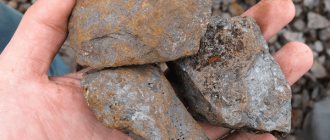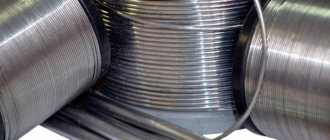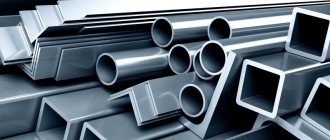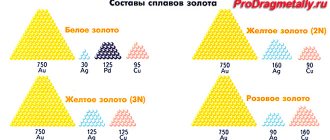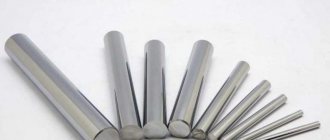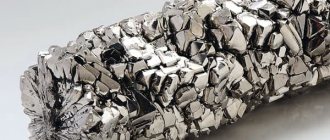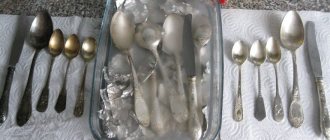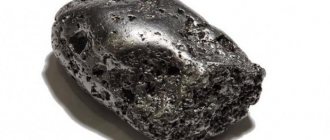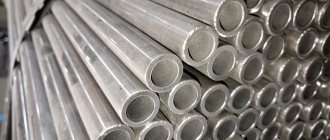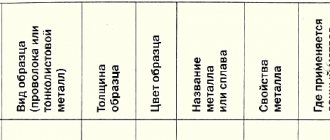General characteristics of titanium and its alloys
It is the basic mechanical properties of titanium alloys that determine their wide distribution. If you do not pay attention to the chemical composition, then all titanium alloys can be characterized as follows:
- High corrosion resistance. The disadvantage of most metals is that when exposed to high humidity, corrosion forms on the surface, which not only worsens the appearance of the material, but also reduces its basic performance qualities. Titanium is less susceptible to moisture than iron.
- Cold resistance. Too low a temperature causes the mechanical properties of titanium alloys to be significantly reduced. You can often encounter a situation where operation at subzero temperatures causes a significant increase in fragility. Titanium is quite often used in the manufacture of spacecraft.
- Titanium and titanium alloys have relatively low densities, which significantly reduces weight. Light metals are widely used in a wide variety of industries, for example, in aircraft manufacturing, skyscraper construction, and so on.
- High specific strength and low density are characteristics that are rarely combined. However, it is precisely due to this combination that titanium alloys are most widely used today.
- Manufacturability during pressure processing determines that the alloy is often used as a workpiece for pressing or other types of processing.
- The lack of response to the influence of a magnetic field will also be called the reason why the alloys in question are widely used. You can often encounter a situation where the production of structures is carried out, the operation of which generates a magnetic field. The use of titanium eliminates the possibility of bonding.
These main advantages of titanium alloys have determined their fairly wide distribution. However, as previously noted, much depends on the specific chemical composition. An example is that hardness changes depending on which substances are used for alloying.
It is important that the melting point can reach 1700 degrees Celsius. Due to this, the resistance of the composition to heat significantly increases, but the processing process also becomes more complicated.
Titanium slag production
The main purpose of this process is to separate iron oxides from titanium oxide. To do this, ilmenite concentrate is melted in a mixture with charcoal and anthracite in electric furnaces, where iron oxides and part of titanium are reduced according to the reaction:
3(FeO TiO2) + 4C = 3Fe + Ti3O5 + 4CO
The reduced iron is carburized, forming cast iron, which collects at the bottom of the furnace bath, separating from the rest of the slag mass due to the difference in their specific gravities. Cast iron and slag are poured separately into molds. The resulting titanium slag contains 80 – 90% TiO2.
Types of titanium alloys
Titanium alloys are classified according to a fairly large number of characteristics. All alloys can be divided into several main groups:
- High-strength and structural - durable titanium alloys, which also have fairly high ductility. Due to this, they can be used in the manufacture of parts subject to variable loads.
- Low-density heat-resistant alloys are used as a cheaper alternative to heat-resistant nickel alloys within a certain temperature range. The strength of such a titanium alloy can vary over a fairly wide range, depending on the specific chemical composition.
- Titanium alloys based on a chemical compound present a heat-resistant structure with low density. Due to a significant reduction in density, the weight is also reduced, and the heat resistance allows the material to be used in the manufacture of aircraft. In addition, this brand is also associated with high plasticity.
The marking of titanium alloys is carried out according to certain rules, which make it possible to determine the concentration of all elements. Let's take a closer look at some of the most common types of titanium alloys.
Titanium alloy spheres
When considering the most common grades of titanium alloys, you should pay attention to VT1-00 and VT1-0. They belong to the class of technical titans. The composition of this titanium alloy includes a fairly large number of various impurities, which determine a decrease in strength. However, due to a decrease in strength, ductility increases significantly. High technological plasticity determines that technical titanium can be obtained even in the production of foil.
Very often the alloy composition in question is cold-worked. Due to this, strength increases, but ductility is significantly reduced. Many experts believe that the processing method in question cannot be called the best, since it does not have a comprehensive beneficial effect on the basic properties of the material.
The VT5 alloy is quite common and is characterized by the use of exclusively aluminum as an alloying element. It is important to note that aluminum is considered the most common alloying element in titanium alloys. This is due to the following points:
- The use of aluminum can significantly increase elastic moduli.
- Aluminum also allows you to increase the value of heat resistance.
- This metal is one of the most common of its kind, due to which the cost of the resulting material is significantly reduced.
- The indicator of hydrogen embrittlement decreases.
- The density of aluminum is lower than that of titanium, due to which the introduction of the alloying substance in question can significantly increase the specific strength.
When hot, VT5 is well forged, rolled and stamped. That is why it is often used for forging, rolling or stamping. Such a structure can withstand exposure to no more than 400 degrees Celsius.
Titanium alloy VT22 can have a very different structure, which depends on the chemical composition. The operational features of the material include the following points:
- High technological plasticity during hot pressure processing.
- Used for the manufacture of rods, pipes, plates, stampings, profiles.
- All the most common methods can be used for welding.
- An important point is that after completion of the welding process, it is recommended to carry out annealing, which significantly increases the mechanical properties of the resulting weld.
The performance qualities of VT22 titanium alloy can be significantly improved by using complex annealing technology. It involves heating to a high temperature and holding for several hours, after which gradual cooling in an oven is carried out, also holding for a long period. After high-quality annealing, the alloy is suitable for the manufacture of highly loaded parts and structures that can heat up to temperatures of more than 350 degrees Celsius. Examples include elements of the fuselage, wings, parts of the control system or fastenings.
Titanium alloy VT6 is now widely used abroad. The purpose of such a titanium alloy is to manufacture cylinders that can operate under high pressure. In addition, according to the results of studies, in 50% of cases in the aerospace industry, a titanium alloy is used, which in its performance qualities and composition corresponds to VT6. The GOST standard today is practically not used abroad to designate titanium and many other alloys, which should be taken into account. The designation uses its own unique marking.
VT6 has exceptional performance properties due to the fact that vanadium is also added to the composition. This alloying element is characterized by the fact that it increases not only strength, but also ductility.
This alloy deforms well when hot, which can also be called a positive quality. When using it, pipes, various profiles, plates, sheets, stampings and many other workpieces are obtained. All modern methods can be used for welding, which also significantly expands the scope of application of the titanium alloy in question. To improve performance, heat treatment is also carried out, for example, annealing or hardening. For a long time, annealing was carried out at temperatures no higher than 800 degrees Celsius, but the results of the studies indicate that it makes sense to increase the indicator to 950 degrees Celsius. Double annealing is often performed to improve corrosion resistance.
Appearance of titanium alloys
The VT8 alloy has also become widespread. Compared to the previous one, it has higher strength and heat-resistant qualities. They were able to achieve unique performance qualities by adding large amounts of aluminum and silicon to the composition. It is worth considering that the maximum temperature at which this titanium alloy can be operated is about 480 degrees Celsius. A variation of this composition can be called VT8-1. We will name the following points as its main operational qualities:
- High thermal stability.
- Low probability of cracks forming in the structure due to the provision of strong bonds.
- Manufacturability when carrying out various processing procedures, for example, cold stamping.
- High ductility combined with increased strength.
To significantly improve performance, double isothermal annealing is often carried out. In most cases, this titanium alloy is used in the production of forgings, ponds, various plates, stampings and other workpieces. However, it is worth considering that the characteristics of the composition do not allow welding work.
Titanium production technology
Titanium is characterized by high mechanical strength, corrosion resistance, heat resistance (Tm = 1660 °C) and low density (4.51 g/cm3). It is used as a structural material in aircraft construction, as well as in the construction of vessels intended for transporting concentrated nitric and dilute sulfuric acids.
TiO2 dioxide is also used for the production of titanium white and enamel. The most common raw material for the production of titanium and Ti dioxide is ilmenite concentrate, isolated during the enrichment of titanomagnetite iron ores, which contains, %: 40-60 TiO2, ~30 FeO, ~20 Fe2O3 and 5-7 waste rock (CaO, MgO, Al2O3 , SiO2), with titanium in the form of the mineral ilmenite FeO • TiO2.
The technological process for the production of titanium from ilmenite concentrate consists of the following main stages:
- obtaining titanium slag by reduction smelting,
- obtaining titanium tetrachloride by chlorination of titanium slag,
- production of titanium (sponge, powder) by reduction from tetrachloride.
Reductive smelting of ilmenite concentrate aims to convert TiO2 into slag and separate iron oxides by reducing them. Melting is carried out in electric arc furnaces. First, the concentrate and reducing agent (coke, anthracite) are loaded and heated to ~ 1650 °C. The main reaction is: FeO • TiO2 + C = Fe + TiO2 + CO. Cast iron is formed from reduced and carburized iron, and titanium oxide turns into slag, which contains 82-90% TiO2.
The production of titanium tetrachloride TiCl4 is carried out by the action of chlorine gas on TiO2 at temperatures of 700–900 ° C, during which the reaction occurs:
TiO2 + 2Cl2 + 2C = TiCl4 + 2CO.
Chlorination is carried out in continuous mine chlorinators or in salt chlorinators. A mine chlorinator is a lined cylinder with a diameter of up to 2 m and a height of up to 10 m, into which briquettes of crushed titanium slag are loaded from above and gas from magnesium electrolyzers containing 65-70% Cl2 is injected from below. The interaction of TiO2 briquettes and chlorine occurs with the release of heat, which provides the temperatures necessary for the process (~ 950 °C in the reaction zone). The gaseous TiCl4 formed in the chlorinator is removed through the top, and the remaining slag from chlorination is continuously discharged from the bottom.
The salt chlorinator is a chamber lined with fireclay, half filled with the spent electrolyte of magnesium electrolyzers, containing potassium, sodium, magnesium and calcium chlorides. Crushed titanium slag and coke are loaded into the melt from above, and chlorine is injected from below. The temperature of 800–850 °C, required for intensive chlorination of titanium slag in the melt, is provided by the heat of the ongoing exothermic chlorination reactions.
Gaseous TiCl4 from the top of the chlorinator is removed to remove impurities, and the spent electrolyte is periodically replaced. The main advantage of salt chlorinators is that expensive briquetting of the charge is not required. The gaseous TiCl4 removed from chlorinators contains dust and gas impurities - CO, CO2 and various chlorides, therefore it is subjected to complex purification carried out in several stages.
Metalathermic reduction of titanium from TiCl4 tetrachloride is carried out with magnesium or sodium. For reduction with magnesium, devices are used, which are a sealed retort 2-3 m high, made of chromium-nickel steel, placed in an oven. After introducing magnesium into a retort heated to ~ 750 °C, titanium tetrachloride is fed into it.
The reduction of titanium by magnesium TiCl4 + 2Mg = Ti + + 2MgCl2 occurs with the release of heat, so the electric heating of the furnace is turned off and the retort is blown with air, maintaining the temperature within 800-900 ° C; it is also regulated by the feed rate of titanium tetrachloride. In one reduction cycle lasting 30-50 hours, 1-4 tons of titanium are obtained in the form of a sponge (solid titanium particles are sintered into a porous mass - a sponge). Liquid MgCl2 is periodically released from the retort.
| Figure 1. Apparatus for the reduction of magnesium tetrachloride: 1 - manifold for air supply and exhaust; 2 - oven; 3 — fitting for vacuuming; 4 — pipe for filling magnesium; 5 — tetrachloride supply unit; b - cover; 7 - retort; 8 - thermocouples; 9 - heater; 10 - drain device |
The titanium sponge absorbs a lot of MgCl2 and magnesium, so after the end of the reduction cycle, impurities are vacuum distilled off. The retort, after heating to ~ 1000 °C and creating a vacuum in it, is kept for 35-50 hours; During this time, impurities evaporate. Sometimes impurities are removed from the sponge after it is removed from the retort.
The reduction of titanium with sodium is carried out in devices similar to those used for magnesium-thermal reduction. In the retort, after feeding TiCl4 and liquid sodium, the titanium reduction reaction occurs: TiCl4 + 4Na = Ti + 4NaCl. The temperature of 800–880 °C is maintained due to the heat released during recovery.
The resulting solid mass containing 17% Ti and 83% NaCl is removed from the reactor, crushed and NaCl is leached from it with water, obtaining titanium powder. Titanium refining. To obtain high-purity titanium, the so-called iodide method is used, which uses the reaction Ti + 2I2 = TiI4. At a temperature of 100–200 °C, the reaction proceeds in the direction of the formation of Til4, and at a temperature of 1300–1400 °C, in the opposite direction.
The titanium sponge (powder) is loaded into a special retort, placed in a thermostat, where the temperature should be at 100-200 ° C, and an ampoule with iodine is broken inside it with a special device. A current is passed through several titanium wires stretched in a retort, as a result of which they are heated to 1300–1400 °C. Iodine vapor reacts with titanium sponges according to the reaction Ti + 2I2 - TiI4.
The resulting TiI4 decomposes on a hot titanium wire, forming crystals of pure Ti and releasing iodine. Iodine vapor again interacts with the refined titanium, and a layer of crystallizing pure titanium gradually builds up on the wire. The process is completed when the thickness of the resulting titanium rod is 25-30 mm. The resulting metal contains 99.9–99.99% Ti; ~ 10 kg of pure titanium per day is obtained in one apparatus.
To obtain malleable Ti in the form of ingots, the sponge is melted in a vacuum arc furnace. A consumable (consumable) electrode is obtained by pressing a sponge and titanium waste. Liquid titanium solidifies in a furnace in a water-cooled crystallizer.
Source [2] → bibliography.
Application of titanium alloys
Considering the areas of application of titanium alloys, we note that most of the varieties are used in the aviation and rocket industries, as well as in the manufacture of marine vessels. Other metals are not suitable for the manufacture of aircraft engine parts due to the fact that when heated to relatively low temperatures they begin to melt, resulting in deformation of the structure. Also, an increase in the weight of elements causes a loss of efficiency.
Titanium alloy knife
Application of titanium alloys in medicine
We will use the material in production:
- Pipelines used to supply various substances.
- Shut-off valves.
- Valves and other similar products that are used in aggressive chemical environments.
- In the aircraft industry, the alloy is used to produce skins, various fasteners, landing gear parts, power sets and other units. As the results of ongoing research show, the introduction of such material reduces weight by approximately 10-25%.
- Another area of application is rocketry. Short-term operation of the engine, movement at high speed and entry into dense layers becomes the reason why the structure experiences serious loads that not all materials can withstand.
- In the chemical industry, titanium alloy is used because it does not react to various substances.
- Titanium is good in shipbuilding because it does not react to the effects of salt water.
In general, we can say that the scope of application of titanium alloys is very extensive. In this case, alloying is carried out, due to which the basic performance qualities of the material are significantly increased.
Titanium alloy pipes
Heat treatment of titanium alloys
To improve performance, titanium alloys are subjected to heat treatment. This process becomes significantly more complicated due to the fact that the restructuring of the crystal lattice of the surface layer takes place at temperatures above 500 degrees Celsius. For VT5 and VT6-S alloys, annealing is often carried out. The holding time may vary significantly, depending on the thickness of the workpiece and other linear dimensions.
Parts made from VT14 must withstand temperatures of up to 400 degrees Celsius at the time of use. That is why heat treatment involves hardening followed by aging. In this case, hardening requires heating the environment to a temperature of about 900 degrees Celsius, while aging involves exposure to an environment with a temperature of 500 degrees Celsius for more than 12 hours.
Induction heating methods allow a wide variety of heat treatment processes to be carried out. Examples include annealing, aging, normalization, and so on. Specific heat treatment modes are selected depending on what performance characteristics need to be achieved.
Reduction of titanium tetrachloride with magnesium
Reduction is carried out in special reactors at temperatures of 950 – 1000 °C. Pig magnesium is loaded into the reactor and, after pumping out the air and filling the reactor cavity with argon, vaporous titanium tetrachloride is fed into it. The process of titanium reduction proceeds according to the reaction:
TiCl4 + 2Mg = Ti + 2MgCl2
Titanium metal settles on the walls, forming a spongy mass, and magnesium chloride in the form of a melt is released through the reactor taphole. As a result of reduction, a reaction mass is formed, which is a titanium sponge impregnated with magnesium and magnesium chloride, the content of which reaches 35–40%.
